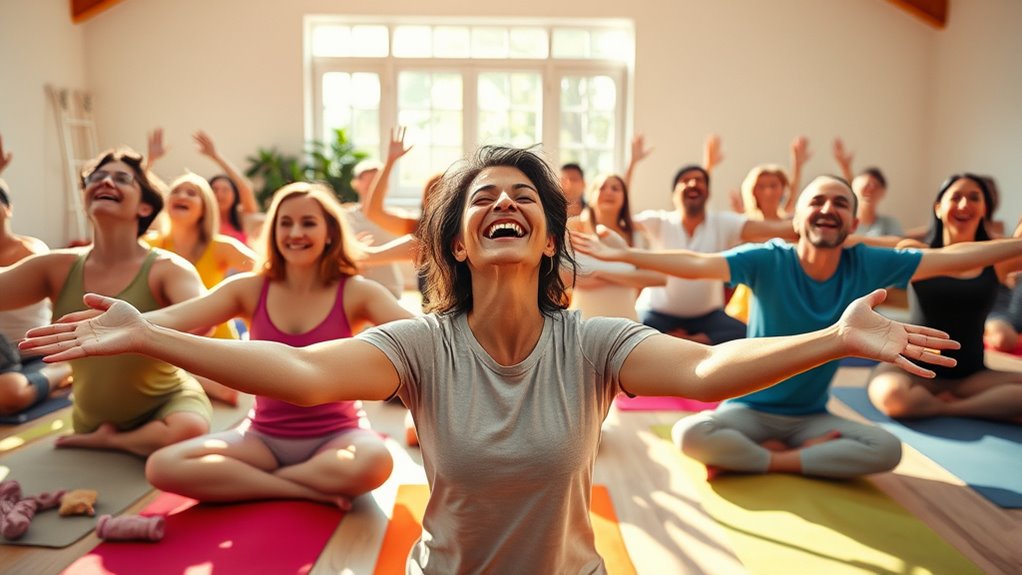Mindfulness & Well‑Being
Resilience Training: Techniques Navy SEALs Use for Mental Toughness
Unlock Navy SEALs’ resilience techniques and discover how to build unbreakable mental toughness that can transform your life.

To build mental toughness like Navy SEALs, focus on shifting your mindset to see challenges as growth opportunities. Manage stress through techniques like controlled breathing, visualization, and staying calm under pressure. Embrace discomfort by gradually exposing yourself to tough situations, strengthening your resilience. Clarify your purpose to stay motivated, and develop discipline through regular practice of these techniques. Keep working at it, and you’ll discover more ways to enhance your mental toughness.
Key Takeaways
- Navy SEALs practice controlled breathing and visualization to manage physiological responses and maintain calm under extreme pressure.
- They embrace discomfort through incremental exposure, building mental toughness and resilience in challenging situations.
- SEAL training emphasizes mindset shifts, viewing setbacks as growth opportunities to foster perseverance.
- They develop a strong sense of purpose to stay motivated and committed during intense adversity.
- Regular stress management exercises and mental discipline techniques help SEALs stay focused and resilient in high-stakes environments.

Have you ever wondered how some people bounce back quickly from setbacks while others struggle to recover? The secret often lies in their resilience—the ability to adapt and stay strong in the face of adversity. Navy SEALs, renowned for their mental toughness, use specific resilience training techniques to develop this skill. One of the key elements they focus on is mindset shifts. Instead of viewing challenges as insurmountable obstacles, they learn to see them as opportunities to grow. This change in perception allows you to approach difficulties with a proactive attitude, making setbacks feel less overwhelming. It’s about rewiring your thinking so that failure becomes a stepping stone rather than a dead end. Regular physical activity, such as balance bikes and scooters, also enhances resilience by building physical confidence and emotional stability.
Resilience is about shifting your mindset to see setbacks as growth opportunities rather than obstacles.
Stress management plays a vital role in building resilience. SEAL training emphasizes controlling your physiological and emotional responses to stress. When you learn to stay calm under pressure, you prevent stress from spiraling into panic or burnout. Techniques like controlled breathing, visualization, and meditation are integral to this process. By practicing these methods regularly, you develop a mental discipline that helps you manage stress more effectively. This isn’t about eliminating stress altogether; it’s about learning how to keep it in check so it doesn’t undermine your performance or well-being.
Resilience training also involves embracing discomfort and pushing through it. Navy SEALs are trained to lean into adversity rather than shy away from it. You’ll find that by gradually exposing yourself to challenging situations—whether physical, emotional, or mental—you build confidence and toughness. Over time, your ability to handle setbacks improves because you’ve conditioned your mind to stay focused and composed even when things get tough. This process of incremental exposure and positive reinforcement fosters a resilient mindset that can adapt to almost any situation.
Another aspect of resilience training is cultivating a sense of purpose. SEALs often rely on their strong “why”—the reason they push through hardships—to fuel their persistence. You can adopt this approach by clarifying your core motivations and values. When setbacks occur, having a clear sense of purpose helps you stay motivated and committed to your goals. It reinforces your mindset shifts, reminding you that difficulties are temporary and that perseverance will lead to growth.
In short, building resilience isn’t about avoiding stress or failure but about developing the mental tools to handle them effectively. By adopting mindset shifts, managing stress, embracing discomfort, and grounding yourself in purpose, you can strengthen your mental toughness just like Navy SEALs do. Practicing resilience techniques and developing these skills can transform setbacks into opportunities for growth and resilience.
Frequently Asked Questions
What Are the Long-Term Mental Health Benefits of Resilience Training?
The long-term mental health benefits of resilience training include improved emotional stability and better stress management. You’ll develop skills to handle setbacks calmly and maintain focus during difficult times. Over time, this training helps you build confidence and reduces anxiety, making you more adaptable and resilient. By consistently practicing these techniques, you strengthen your mental toughness, leading to a healthier, more balanced mindset that lasts well beyond initial training.
How Do Resilience Techniques Differ Between Navy SEALS and Civilians?
You’ll find that resilience techniques differ mainly in intensity and focus. Navy SEALs develop a combat mindset through rigorous stress adaptation, pushing their mental limits in extreme conditions. Civilians typically use similar methods but adapt them to everyday stressors, emphasizing emotional regulation and confidence. While SEALs train to withstand life-threatening stress, civilians focus on building mental toughness for daily challenges, making resilience techniques versatile but tailored to different levels of adversity.
Can Resilience Training Be Customized for Individual Mental Health Needs?
You can absolutely customize resilience training to fit your mental health needs. Personalization strategies involve tailoring exercises based on mental health assessments, ensuring the techniques address your specific challenges. This approach makes the training more effective by focusing on areas like stress management or emotional regulation that matter most to you. By incorporating assessments and personalized plans, resilience training becomes a powerful tool to strengthen your mental well-being uniquely.
What Role Does Nutrition Play in Mental Toughness Development?
You might wonder how nutrition influences mental toughness. Proper diet optimization fuels your brain, enhances focus, and reduces stress. Incorporate supplement strategies like omega-3s or B-vitamins to support cognitive function and resilience. By paying attention to what you eat and supplement, you can strengthen your mental resilience, improve mood, and stay sharp under pressure. Nutrition becomes an essential part of your mental toughness toolkit, empowering you to perform at your best.
Are There Any Common Misconceptions About Resilience Training Methods?
Ah, the myth debunking dance of resilience training methods! Many believe these techniques are quick fixes or just military bravado. The truth? Training myths often oversimplify mental toughness, making you think you can boost resilience overnight. In reality, it’s a disciplined process, not magic. So, don’t fall for the hype—real resilience takes consistent effort, patience, and a willingness to face discomfort head-on.
Conclusion
You might think resilience is about never breaking, but Navy SEALs show it’s about embracing vulnerability and setbacks. They face extreme challenges, yet emerge stronger—proof that mental toughness isn’t about avoiding stress, but mastering it. Like steel forged in fire, your resilience grows through adversity, not in spite of it. So, when life’s pressures mount, remember: your strength isn’t the absence of struggle, but your ability to stand tall amid it.
Mindfulness & Well‑Being
Guided Imagery Scripts for Stress Relief
Feeling overwhelmed? Discover how guided imagery scripts can help you relax and find peace in moments of stress.

Guided imagery scripts for stress relief help you relax by guiding you through calming mental scenes, combined with deep breathing and muscle relaxation. You’ll visualize peaceful places like beaches or forests, focusing on sensory details to quiet your mind. Incorporating slow breath patterns deepens your relaxation and reinforces the calming effects. Consistent practice trains your body and mind to respond quickly to stress, making relaxation accessible whenever you need it. Keep exploring to discover more effective techniques for stress relief.
Key Takeaways
- Guided imagery scripts typically involve calming mental scenes like beaches, forests, or streams to promote relaxation.
- Incorporate deep breathing techniques within scripts to deepen stress relief and sensory engagement.
- Use progressive muscle relaxation cues alongside visualization to release physical tension effectively.
- Scripts should be practiced regularly to train the mind and body for quick stress response.
- Combining visualization with breathing and muscle relaxation enhances overall emotional well-being and calmness.

Guided imagery scripts are a powerful tool for reducing stress and promoting relaxation. When you use these scripts, you’re guided through calming mental pictures that help quiet your mind and ease tension in your body. One of the most effective ways to deepen your relaxation is by combining guided imagery with relaxation techniques like deep breathing. As you listen or read through a script, focus on taking slow, deliberate breaths, inhaling deeply through your nose and exhaling fully through your mouth. This deep breathing helps oxygenate your body, slow your heart rate, and foster a sense of calm. It’s a simple yet powerful method to anchor your mind during the visualization process, making it easier to let go of stress and intrusive thoughts.
Using guided imagery along with relaxation techniques allows you to create a peaceful mental space that feels safe and soothing. As you follow the script, you might imagine yourself walking through a quiet forest, sitting beside a gentle stream, or lying on a warm beach. Visualizing these scenarios becomes more vivid when combined with deep breathing, which enhances the sensory experience. For example, as you picture yourself sitting on a soft blanket under the shade of trees, take a slow, deep breath to match the tranquility of the scene. With each exhale, release any tension you’re holding onto. This deliberate breathing pattern not only deepens your sense of relaxation but also helps to reset your nervous system from stress mode to calm.
Incorporating relaxation techniques into guided imagery also involves consciously relaxing different muscle groups. As you listen to or read the script, you might be prompted to tense and then release your muscles, starting from your toes and working up to your shoulders. When combined with mindful deep breathing, this progressive muscle relaxation amplifies the calming effect. It’s a way to signal to your body that it’s safe to unwind, making it easier to let go of worries and physical tension. Over time, practicing these techniques together can help you develop a natural response to stress, where deep breathing and visualization become your go-to tools for instant relief.
Ultimately, the key to benefiting from guided imagery scripts is consistency. When you regularly practice these relaxation techniques alongside vivid visualization, you train your mind and body to respond quickly and effectively to stress. Whether you’re dealing with daily pressures or more intense anxiety, integrating deep breathing and relaxation strategies into guided imagery can transform your stress management routine, helping you find calm and clarity whenever you need it.
Frequently Asked Questions
Can Guided Imagery Replace Therapy for Stress Management?
You might wonder if guided imagery can replace therapy for stress management. While it strengthens your mind-body connection and improves emotional regulation, it’s often a complementary tool rather than a complete substitute. Guided imagery helps you relax and gain insight, but therapy provides personalized strategies and support for deeper issues. Combining both offers a balanced approach, empowering you to manage stress effectively and build lasting resilience.
How Often Should I Practice Guided Imagery for Best Results?
You might find it surprising, but consistent practice really boosts results. To get the most from guided imagery, aim for daily sessions, about 10-15 minutes each. This practice frequency helps reinforce relaxation, while an ideal duration ensures you stay engaged without feeling overwhelmed. Stick with this routine, and you’ll likely notice stress reducing more effectively over time, turning calming imagery into a natural part of your self-care.
Are There Any Risks or Contraindications With Guided Imagery?
You might wonder if guided imagery has risks. Generally, it’s safe, but be aware of physical risks if you have health issues that could be affected by relaxation or visualization. Emotional triggers could also arise if certain images evoke strong feelings or memories. If you notice distress, stop and consult a healthcare professional. Always approach guided imagery gently, especially if you’re prone to emotional sensitivities or physical concerns.
Can Children or Seniors Effectively Use Guided Imagery Scripts?
You might wonder if children or seniors can benefit from guided imagery scripts. Research shows that child-friendly techniques and senior relaxation methods are effective, as they adapt to different cognitive levels and needs. Children often respond well to simple, playful scripts, while seniors find visualization calming and accessible. With proper guidance, both groups can use guided imagery to reduce stress, improve mood, and enhance overall well-being.
How Do I Create Personalized Guided Imagery Scripts?
To create personalized guided imagery scripts, start by identifying your favorite relaxation imagery themes, like peaceful beaches or calming forests. Use personalization techniques such as including specific sensory details and personal preferences to make the script resonate deeply. Focus on vivid, descriptive language that engages your senses. This way, your script feels uniquely tailored, helping you relax more effectively as you visualize these calming scenes.
Conclusion
As you embrace these guided imagery scripts, remember that you’re wielding a powerful tool akin to Icarus’s wings—capable of lifting you above stress if used wisely. With each breath, you forge a path toward serenity, much like the steady river carving its course through the landscape. Trust in this journey, knowing that, like the phoenix rising from ashes, you can renew your calm and resilience whenever life’s pressures threaten to overwhelm you.
Mindfulness & Well‑Being
The Science of Laughter Yoga and Everyday Joy

Laughter yoga combines intentional laughter with deep breathing exercises, offering real mental, physical, and emotional health benefits. It boosts your mood by releasing feel-good chemicals like endorphins and relaxes your body, reducing stress hormones. The practice also improves circulation, strengthens muscles, and promotes better sleep. By regularly practicing laughter yoga, you can build resilience and find joy in everyday life. If you’re curious, exploring how this simple activity impacts your well-being can be quite revealing.
Key Takeaways
- Laughter yoga combines intentional laughter with deep breathing, triggering neurochemical releases that boost mood and reduce stress.
- It enhances physiological health by increasing oxygen intake, lowering blood pressure, and strengthening immune function.
- Regular practice fosters social bonds and shared joy, promoting emotional resilience and combating loneliness.
- The practice activates muscles and stimulates blood flow, contributing to physical vitality and cardiovascular health.
- Overall, laughter yoga creates a holistic sense of well-being by integrating mental uplift with physical relaxation and energy.

Laughter yoga combines intentional laughter with deep breathing exercises to promote physical and mental well-being. When you engage in laughter yoga, you’re not just making funny faces or giggling aimlessly—you’re actively triggering a range of psychological benefits and physiological responses that can enhance your overall health. The combination of laughter and controlled breathing stimulates your nervous system, leading to a cascade of positive effects. As you laugh, your brain releases feel-good chemicals like endorphins, which lift your mood and reduce stress. This mental shift can help you feel more relaxed, confident, and resilient in everyday situations.
Laughter yoga boosts mental and physical health through intentional laughter and deep breathing.
One of the key psychological benefits of laughter yoga is its ability to diminish feelings of anxiety and depression. When you laugh intentionally, you break the cycle of negative thoughts that often plague your mind. It’s like a reset button for your mental state, making it easier to approach challenges with a more optimistic outlook. Plus, laughter fosters social connection, which is essential for emotional health. When you participate in group laughter sessions, you experience a sense of community and shared joy, strengthening your social bonds and reducing feelings of loneliness or isolation. Engaging in protective styling benefits through activities like laughter yoga also encourages a holistic approach to health and wellness.
On the physiological level, laughter yoga prompts your body to respond in ways that boost your physical health. Deep breathing exercises involved in the practice increase oxygen intake, improving circulation and energizing your tissues. This physiological response can lower blood pressure and enhance your immune function, making you more resilient to illnesses. The rhythmic breathing also helps relax your muscles and calms your nervous system, reducing stress hormones like cortisol. Over time, these responses contribute to better cardiovascular health and improved sleep patterns.
Furthermore, the act of laughing itself is a physical activity that engages your core muscles, facial muscles, and even your diaphragm. This not only boosts muscular tone but also stimulates the release of nitric oxide, which helps relax blood vessels and promote healthy blood flow. Many practitioners report feeling more energized and less fatigued after laughter yoga sessions. The combination of mental uplift and physical stimulation creates a holistic sense of well-being, making it easier for you to handle daily stresses with a positive attitude.
In essence, laughter yoga’s intentional practice taps into your body’s natural ability to heal and rejuvenate. By consciously engaging in this joyful activity, you’re harnessing the power of psychological benefits and physiological responses that can transform your outlook and overall health. It’s a simple, accessible way to infuse more joy into your life, fostering resilience and vitality in both body and mind.
Frequently Asked Questions
Can Laughter Yoga Be Effective if I Don’t Naturally Laugh Easily?
If you don’t laugh easily, laughter yoga can still be effective. It encourages you to focus on laughter authenticity rather than genuine humor, helping you relax and open up. Social influence plays a big role, so participating with others can make it easier to engage. Over time, even forced laughter can boost your mood and create genuine joy, proving that laughter yoga benefits everyone, regardless of natural laughter tendencies.
How Long Does It Take to See Benefits From Regular Laughter Yoga Practice?
Think of laughter yoga as planting seeds of joy; with time, blooms appear. Your timing expectations depend on consistency and your unique body’s response. Some notice mood lifts within a few sessions, while others see progress indicators like reduced stress or better sleep after several weeks. Keep practicing, and you’ll find the rhythm that unlocks your laughter’s healing potential. Patience turns your efforts into a garden of daily happiness.
Are There Any Risks or Contraindications for Laughter Yoga Participants?
You might wonder about laughter safety and potential contraindications risks when practicing laughter yoga. Generally, it’s safe for most people, but if you have respiratory issues, heart problems, or are pregnant, you should consult your doctor first. Avoid intense laughter exercises if you feel dizzy or uncomfortable. Being aware of these contraindications risks helps make certain you enjoy the benefits of laughter yoga safely and comfortably.
Does Laughter Yoga Work Equally Well for All Age Groups?
You might think laughter yoga isn’t suitable for all ages, but it actually offers age-specific benefits and adapts well across ages. Whether you’re young or senior, you can find tailored exercises that suit your needs, promoting relaxation, social connection, and stress relief. Its flexibility guarantees everyone can participate comfortably, making it an inclusive practice that enhances well-being regardless of age.
How Does Laughter Physiologically Impact Stress Levels and Immune Function?
Laughter impacts your physiology by triggering an endocrine response that releases feel-good hormones like endorphins. It activates neural pathways in your brain, reducing stress hormones like cortisol. This combination boosts your immune function, making you less susceptible to illness. When you laugh, you enhance your body’s ability to manage stress, leading to improved overall health and resilience. So, laughter isn’t just fun—it’s a powerful health tool.
Conclusion
So, by embracing laughter yoga, you’re revealing the secret to turning every dull moment into a nonstop comedy show! Imagine laughing so hard that your happiness skyrockets to the moon and back, making stress vanish faster than you can say “giggle attack.” With just a little practice, you’ll wield the power to turn the ordinary into extraordinary, transforming your daily life into a never-ending carnival of joy. Get ready—laughter truly is the world’s most magical medicine!
Mindfulness & Well‑Being
Mindful Tech Use: Setting Intentional Screen Boundaries
Set intentional screen boundaries to cultivate mindful tech habits—discover practical strategies that can transform your digital experience and enhance well-being.

To practice mindful tech use, set clear boundaries around your device habits. Designate specific times for checking emails or social media, especially during meals or after work. Turn off non-essential notifications to minimize interruptions. Keep your phone out of reach during important moments and create device-free zones like the bedroom. Periodic digital detoxes and environmental cues, such as focused spaces, help reinforce these boundaries, leading to a healthier tech relationship—if you continue exploring, you’ll discover more practical ways to maintain balance.
Key Takeaways
- Set specific times for checking devices to prevent mindless scrolling and maintain focus.
- Create designated device-free zones to promote real-world interactions and reduce digital distractions.
- Turn off non-essential notifications to minimize interruptions and enhance mindful engagement.
- Use environmental cues, like keeping phones out of reach during meals, to reinforce boundaries.
- Schedule regular digital detox periods to reset habits and cultivate a more intentional tech relationship.

Have you ever stopped to contemplate how your tech habits impact your daily life? In a world where screens are constantly within reach, it’s easy to get caught in a cycle of endless scrolling, notifications, and alarms. While technology can boost productivity and connect you with others, it can also drain your mental energy and create a sense of overwhelm. Practicing mindful tech use means intentionally setting boundaries to regain control over your digital environment. One effective approach is implementing a digital detox — a deliberate break from screens to refresh your mind and prioritize real-world experiences. This doesn’t mean you need to cut out all technology forever; rather, it’s about creating space for reflection and intentionality.
Establishing tech boundaries is a *vital* step in this process. Think of tech boundaries as guardrails that prevent your devices from taking over your day. You might decide to designate specific times when you check emails or social media, such as during lunch or after work, rather than constantly reacting to every notification. Limiting screen time before bed can also improve your sleep quality, helping you wake up feeling more rested and focused. These boundaries help you develop a healthier relationship with technology, ensuring it serves your goals rather than distracts from them. Be honest with yourself about what’s truly necessary and what’s just habitual scrolling. Setting clear limits empowers you to use tech intentionally, rather than passively.
To reinforce these boundaries, consider creating physical or environmental cues. For example, keep your phone out of reach during meals or work sessions, or turn off notifications that aren’t urgent. You might also establish device-free zones in your home, like the dining area or bedroom, to promote presence and reduce temptation. Implementing a digital detox periodically—say, a weekend or even a day—can help reset your habits and remind you of life beyond screens. During these detoxes, focus on engaging with nature, reading, or connecting face-to-face with loved ones. These intentional pauses allow your mind to rest and reset, fostering mindfulness about your tech use. Incorporating contrast ratio awareness can also help you adjust your environment for optimal viewing comfort and reduce eye strain during screen time.
Frequently Asked Questions
How Can I Identify When My Tech Use Is Excessive?
When you wonder if your tech use is excessive, pay attention to how often you reach for your devices and how it affects your daily life. Signs include feeling anxious without your phone or neglecting important tasks. To foster tech mindfulness, try a digital detox regularly to reset your habits. Recognizing these patterns helps you set healthier boundaries and enjoy technology without letting it control you.
What Are Simple Daily Habits to Reduce Screen Time?
Imagine a world where your phone doesn’t rule every moment—sounds like a digital detox dream, right? To reduce screen time daily, create screen-free zones like the dinner table or bedroom. Set small habits, like checking your device only at specific times, and enjoy real-world moments. These simple routines help you break free from constant scrolling, giving your mind a well-deserved break and making space for genuine connections.
How Does Mindful Tech Use Improve Mental Health?
Mindful tech use boosts your mental health by encouraging you to take digital detox breaks, helping you disconnect and recharge. When you set intentional boundaries, you reduce stress and prevent overwhelm, strengthening your emotional resilience. By being aware of your screen habits, you foster healthier relationships with technology, leading to better mood and focus. Ultimately, mindful use empowers you to control your digital environment, supporting your overall mental well-being.
Can Setting Boundaries Affect My Relationships Positively?
Setting boundaries is like planting seeds for healthier relationships. When you establish a digital detox and find your tech balance, you create space for genuine connection. This shows others that you value quality time, leading to trust and understanding. By intentionally managing your screen time, you foster more meaningful interactions, reducing misunderstandings and strengthening bonds. Your effort to set boundaries positively impacts your relationships, making them more resilient and fulfilling.
What Tools Can Help Monitor and Limit Screen Time Effectively?
To monitor and limit your screen time effectively, you can use digital well-being tools built into your device or third-party app blockers. These tools help you set daily limits and track usage, making you more aware of your habits. By actively using app blockers, you prevent overuse and create healthier digital habits. Incorporating these tools into your routine supports mindful tech use and strengthens your overall well-being.
Conclusion
By bravely boundary-setting and boldly balancing your screen time, you bring clarity to chaos and create calm from clutter. Mindful tech use transforms tumult into tranquility, fostering focus and freedom. With conscious choices and consistent cues, you craft a caring, controlled connection to technology. Remember, your deliberate decisions direct your digital destiny—so step softly, stay steady, and seize control for a healthier, happier, more harmonious life.
-

 Wish Notes1 year ago
Wish Notes1 year agoBest Caption to Wish Myself a Happy Birthday That Everyone Will Like!
-

 Wish Notes1 year ago
Wish Notes1 year agoThe Best Birthday Wishes to Make Your Uncle's Day Bright!
-

 Wish Notes1 year ago
Wish Notes1 year agoThe Sweetest Happy Birthday Wishes for Your Wife!
-

 Wish Notes1 year ago
Wish Notes1 year agoThe Best Happy Birthday Wish for Your Brother That Will Make Him Smile!
-

 Wish Notes1 year ago
Wish Notes1 year agoHeartwarming Birthday Messages for Mom in Spanish
-

 Wish Notes1 year ago
Wish Notes1 year agoThe Best Happy Birthday Wishes for Your Husband That Will Make His Day!
-

 Wish Notes1 year ago
Wish Notes1 year agoThe Ultimate Birthday Wishes to Celebrate Yourself!
-

 Wish Notes1 year ago
Wish Notes1 year agoThe Most Heartfelt Good Night Wishes Ever!















